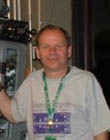|
|
This topic comprises 2 pages: 1 2
|
|
Author
|
Topic: Dimmable CFL's in the auditoriums
|
|
|
|
|
|
|
|
|
|
|
|
|
Frank Angel
Film God

Posts: 5305
From: Brooklyn NY USA
Registered: Dec 1999
|
 posted 08-19-2008 10:46 AM
posted 08-19-2008 10:46 AM





quote: Mark Gulbrandsen
Oops! Left out an important trait of florescents and that is they tend to glow for a while after they have been turned off.
AND, they don't come to full brightness until a good minute, minute & half after they are brought up to full.
As far as being dimmable (the ones that say they are made specificially for being able to be dimmed -- forget about the standard ones) it's a joke. THEY SUCK. I didn't do the extensive experimentation that Mark has done on them, all I needed was to have a slew of them either overheat and smoke to death like Jim's, or even when they did work down to that totally unacceptable 25, 30% blink out level, they would die prematurely. CFLs, even when they don't go up in smoke on you are much too unreliable (some of ours even in regular non-dim service die very early on).
The only way CFLs will work in dimming situations with the same effectivness as incandescents, is if they are in fixtures like they have at Radio City Music Hall -- fixtures that have an iris and a small motor controlled by the DMX signals from the lighting console. The iris is what dims the light, not the light source. Such a fixture doesn't have to be elaborate, just an enclosure and a simple vane that can be opened and closed by a micro motor. Yah, it could be done, but there goes any savings you might get from using CFLs, no matter how inexpensive they could make such a fixture.
| IP: Logged
|
|
|
|
|
|
|
|
|
|
|
|
|
|
|
|
|
|
|
|
All times are Central (GMT -6:00)
|
This topic comprises 2 pages: 1 2
|
Powered by Infopop Corporation
UBB.classicTM
6.3.1.2
The Film-Tech Forums are designed for various members related to the cinema industry to express their opinions, viewpoints and testimonials on various products, services and events based upon speculation, personal knowledge and factual information through use, therefore all views represented here allow no liability upon the publishers of this web site and the owners of said views assume no liability for any ill will resulting from these postings. The posts made here are for educational as well as entertainment purposes and as such anyone viewing this portion of the website must accept these views as statements of the author of that opinion
and agrees to release the authors from any and all liability.
|

 Home
Home
 Products
Products
 Store
Store
 Forum
Forum
 Warehouse
Warehouse
 Contact Us
Contact Us




 Printer-friendly view of this topic
Printer-friendly view of this topic






![[Eek!]](eek.gif) .
.











